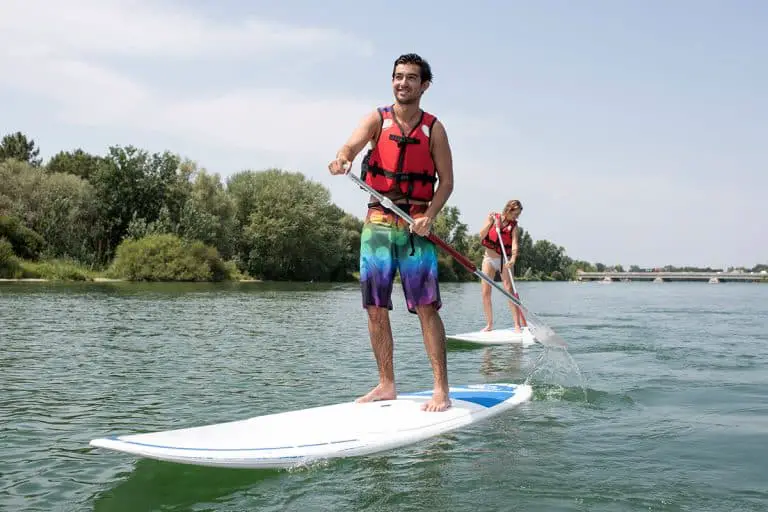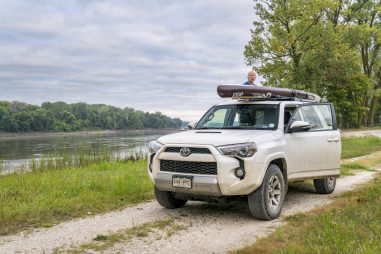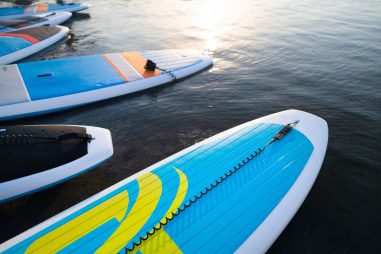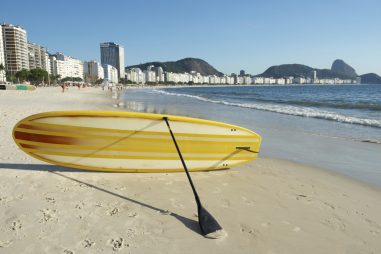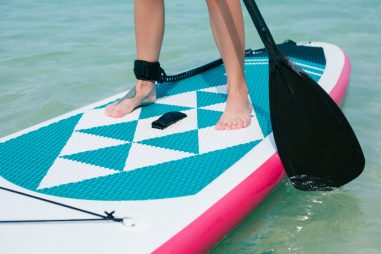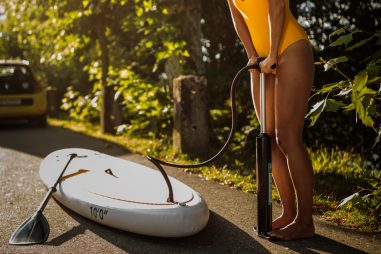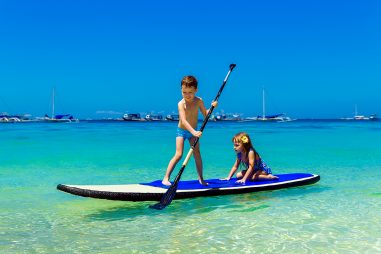Paddle boarding is one of the most famous water activities in the world due to the ease of the sport. It only requires a few basic gears, and you can easily learn the sport under the supervision of a qualified instructor. Paddle boarding is also considered to be a safe sport if practiced wisely and with caution.
Is Paddle Boarding Safe or Dangerous?
Paddle boarding is generally considered to be a safe sport. However, like all sports, paddle boarding can be dangerous, especially if pursued recklessly. At the end of the day, paddle boarding is as safe or dangerous as you make it to be.
Some of the dangers of paddle boarding include going in the water when the conditions of either the weather, wind, or water are bad, not knowing how to swim, going in shallow water, and skipping your personal flotation device, among others. Accidents caused by one or any combination of these dangers can be significantly lessened if you do the sport safely.
Do You Need a Personal Flotation Device (PFD) on a Paddle Board?
It pays to wear a personal flotation device while you are paddle boarding as another layer of protection. While the actual board can act as a flotation device, a lot of things can happen that can prevent you from reaching and holding on to the board. When this happens, your personal flotation device can be your lifeline.
You can choose between a life jacket or an inflatable belt as your PFD. Both of these can save your life in case an accident happens.
Should You Wear a Life Jacket When Paddle Boarding?
Nowadays, the deciding factor between wearing or skipping your life jacket depends on where you are in the world. Many countries require the use of personal flotation devices, specifically life jackets before you can even ride your paddle board.
While some life jackets can be restrictive to movements, there are new designs that allow you to move freely. Now you have the freedom to paddle board anywhere with the thought that you are safe because you are wearing your life jacket.
What Is the Best Life Jacket for Paddle Boarding?
If you are on the lookout for a new life jacket, here are some of the best in the market today.
- Onyx Movement Dynamic PFD: Considered to be the best life jacket for most paddlers, the Onyx Movement Dynamic PFD is a U.S. Coast Guard approved Type III PFD. It is made with heavy-duty nylon, and it is designed with comfort in mind. Not only is it a great life jacket for paddle boarding, but it is also a great choice for all sorts of water activities. The mesh panels make it more breathable, and it also has an attached whistle. This life jacket is lightweight, extremely comfortable, and has a pocket!
- Astral Greenjacket PFD: Made from 200 & 500 Denier Cordura Nylon, the Astral Greenjacket PFD is the choice of serious paddlers. This comfortable life jacket has a two-panel fit system which decreases the likelihood of the life jacket from riding up. It has large pockets and is made with YKK zippers. It is also equipped with a quick-release system in case of emergencies which makes it the go-to jacket of whitewater rescue teams. It does come with a hefty price tag, but its superior quality more than makes up for its price.
- Stohlquist Edge Life Jacket: A Type III PFD, the Stohlquist Edge Life Jacket offers great mobility and comfort. It is designed to have extra large armholes for high mobility, mesh siding for ventilation, and it also has a very roomy zipper pocket located at the front. The Stohlquist Edge Life Jacket is also very affordable, and it comes with a whistle in case of emergency. However, the sizes run small, so you might want to rethink purchasing this life jacket if you need bigger ones.
- Astral YTV Life Jacket: A pullover-type of personal flotation device, the Astral YTV Life Jacket is a great choice for both paddle boarders and kayakers. It features a Torso Lock fit which lessens the likelihood of it riding up. It is made with 200 x 400 Denier Ripstop Nylon and YKK zippers. It is also designed to have two zipper pockets. The Astral YTV is a Type V PFD, impressively lightweight, and is in the mid-range price point.
- Stearns Adult Classic Life Jacket: Often referred to as the best budget PFD, the Stearns Adult Classic Life Jacket is a great option if you want a life jacket that is not only comfortable on your body but is also great for your wallet. The Stearns Adult Classic is made with Nylon and has a universal fit. It is a Type I PFD, which makes it great for many types of water activities. If you are a beginner paddle boarder, this is a great choice for a starter life jacket. However, while it is designed for a universal fit, it may not fit you comfortably if you are very thin or on the bigger side.
- Stohlquist Escape Youth Fit PFD: If your kid is interested in water activities, then the Type III Stohlquist Escape Youth Fit PFD will be a great choice. The Stohlquist Escape has two sizes and will fit any kid weighing anything between 50 pounds to 125 pounds. It is both very comfortable and durable because it is constructed with 200D nylon and 200D oxford liner. The Stohlquist Escape also offers high mobility because it is designed to have a high shoulder cut.
- NRS Vapor PFD: Often considered to be the best life jacket for tall paddle boarders due to its narrow torso and longer length, the NRS Vapor PFD is a Type III United States Coast Guard-approved PFD. It is made with 200D nylon and features a side buckle, so you can easily put it on and take it off. You can also adjust the fit by tinkering with the buckles on the sides, waist, and shoulders. The cut of the NRS Vapor also offers high mobility. This life jacket is also a great option if you are into stand up paddle board surfing or white river paddling.
- NRS Women’s Siren PFD: The NRS Women’s Siren PFD was made with a woman’s needs in mind. It features soft foam, which fits nicely on a woman’s body, and it is constructed with 400D ripstop nylon outer fabric and 200D nylon inner lining. The NRS Women’s Siren offers high mobility without compromising comfort. It has a side buckle for entry and a front zipper pocket. This Type III PFD can easily be adjusted to fit any female size.
- NRS Chinook Fishing PFD: If you are into stand up paddle board fishing, then look no further because the NRS Chinook Fishing PFD might just be the one for you. This Type III PFD is made with 400D ripstop nylon and features five (yes, five!!!) front pockets. It also has multiple adjustment systems, so you can tinker with the fit. It is very comfortable, and it also offers high mobility with its high shoulder design.
Is It Illegal to Paddle Board Without a Life Jacket?
Paddle boarding without a life jacket is not illegal per se, but in many places, it is a requirement. Most countries consider paddle boards as a kind of water vehicle. As such, wearing a life jacket or any form of PFD is a requirement if you ever want to take your paddle board on a spin.
The good thing, though, is that life jackets are now designed to be less restrictive. This means that you can wear a life jacket while doing all sorts of water activities. You can enjoy your time on the water while also being safe.
Can You Paddle Board Without Knowing How To Swim?
Technically you can paddle board without knowing how to swim. That’s where your personal flotation device comes in. It does give you another layer of security if ever you get knocked off on your paddle board.
However, it is still better if you know how to swim or if you are at least comfortable in the water. Paddle boarding is a water sport, and no matter how experienced you are in this sport, there will come a time that you will be knocked off your board straight into the water, so knowing how to swim would be a great plus.
Is Paddle Boarding Safe for Non-swimmers?
Paddle boarding is generally a safe sport, even for non-swimmers. If you don’t know how to swim, you have to be wise and wear your life jacket or your personal flotation device of choice. The great thing about paddle boarding is that you can learn the sport regardless of your age and skills.
Aside from wearing your life jacket or PFD, there are other ways to ensure your safety while paddle boarding if you don’t know how to swim. For one, try paddle boarding in shallow water at first. Another thing that you can do to ensure your safety is to not try paddle boarding without the supervision of a qualified instructor, and don’t go in the water if the waves are too big or the wind is too strong.
Can You Paddle Board Alone?
Paddle boarding is technically a solo sport because you are alone on your paddle board most of the time. But it is also wise to bring a buddy with you on your adventures. Have a friend with you adds another layer of comfort, knowing that someone is overseeing your safety and progress as you enjoy your time in the water.
As with any sport, you don’t really know when catastrophes will happen, so it is very important that someone is near in case you would need help.
Is It Safe to Paddle Board Alone?
It is safe to paddle board alone; however, it is NOT recommended, so our advice is to not do it. Paddle boarding was made so you can enjoy it with your friends, family members, and even your pets.
Whether you are paddle boarding alone or with friends, take extra precautions to ensure your safety. Wear your personal flotation device, and don’t stray too far from the shore, especially if you are still a beginner.
Can You Paddle Board at Night?
You can definitely paddle board at night, and some even make an activity out of it. In some places, the water and weather conditions during the day can be too harsh, and the conditions during the evening are better for stand up paddle boarding. Many paddle boarding groups and organizations often do nighttime stand up paddle boarding activities.
It is advisable to only paddle board at night when the water is calm, and the moon is bright, or if you have illumination from other sources like the city lights. It is also not advisable to paddle board in the ocean at night or if it is too dark to see your way. Make sure to bring along any lighting device (preferably with white light), a safety whistle, and wear your personal flotation device for maximum safety.
Does Paddle Boarding Attract Sharks?
Yes, like other paddling activities such as kayaking, paddle boarding can attract sharks due to its shape. From a shark’s point of view, the underside of a paddle board does look like a belly of its prey (like a seal), and from that alone, a shark can come up to you.
Another reason why paddle boarding attracts sharks is that they sometimes see the paddle board as a threat. If a small shark sees your board which happens to be bigger than it is, it might mistake your paddle board for a predator, and it might feel threatened.
Aside from that, you have to realize that when we go paddle boarding, we subject ourselves to the natural habitat of sharks. And since you are a new addition to their surroundings, sharks can come up to you out of curiosity.
Do Sharks Attack Paddle Boards?
There have been shark attacks on paddle boards. However, they happen very rarely. The attacks usually happen when the sharks mistake your paddle board as prey or if they feel threatened.
While these happen rarely, it still pays to be vigilant whenever you are out in the water. This also reminds us to never go in the water alone.
What Do You Do if You See a Shark While Paddle Boarding?
The likelihood of seeing a shark while you are out in the ocean can be high; after all, it is their natural habitat. But here are some things that you can do to avoid injury if ever you spot one in the water.
- If you ever see a shark within your midst while paddle boarding, you should paddle away as soon as possible.
- Paddle calmly and slowly back to the shore.
- Make sure to make calculated paddles and try not to attract the shark with erratic movements on your board and paddle.
- Do not try to put your hand (or any body part for that matter) in the water. Keep your whole body on the board.
- Don’t even think of touching the shark.
- Keep your movements controlled. If you panic, you might attract the shark further, or worse, you might be knocked off the board and straight into the water.
Here’s another thing: usually, if there has been any shark sighting in the area, you would hear about it. So, if you hear about the shark news, the smart thing to do is to skip paddle boarding and just chill by the beach.
Is Paddle Boarding Safe With Alligators?
While it is considered safe paddle boarding with alligators, we advise you to proceed with caution, or you know, skip the trip altogether. Since you are the “visitor” to their natural habitat, it is best if you make it as calmly and as quietly as possible. Paddlers say that alligators typically stay away, especially if they see that the board is bigger than them.
But as you would do when there is a shark sighting, maybe it’s best to skip the water if there is an alligator in sight. Alligators can also be extra agitated during the mating or hatching season.
Do Alligators Attack Paddle Boards?
While alligators have attacked paddle boards in the past, this occurrence is very rare. According to reports, deaths due to alligator attacks only account for 1% of the annual human death toll.
Alligators can attack you for many reasons. As with sharks, alligators often attack when they feel threatened or if they mistook you for their prey. They are also very aggressive when you disturb them. If disturbed during the mating or hatching season, gators can be extra agitated.
Do You Need Paddle Board Insurance?
While it is not required by law to get paddle board insurance, it is still nice to have one. Paddle board instructors, guides, and business owners are usually the ones who acquire paddle board insurance, but it is also a good thing to have, even if you just do it for fun or as a hobby.
You do not know how your paddle boarding trip would go, so if ever you end up in an accident on your paddle board, the insurance will serve as a cushion to the expenses that you might incur.
The price of insurance may vary depending on how extensive the coverage is. Usually, they go for as low as 27 dollars to 42 dollars a month in the United States, depending on the coverage. If you are thinking of getting paddle board insurance, it is best to get in touch with the many companies offering this specific type of insurance.
How Dangerous Is Paddle Boarding Actually?
Paddle boarding is generally considered a safe sport, and the inherent dangers that come with it are usually amplified with the recklessness of humans. For instance, choosing to paddle board even when the weather is bad, or the waves are big, or paddle boarding without a personal flotation device can only result in disaster. But these are choices made by man; ergo, paddle boarding is as safe or as dangerous as you make it to be.
Paddle boarding really is safe if you only put your safety on the forefront. Remember to wear your PFD, go with a buddy, and get out of the water when you see a shark or a gator are just a few of the things that you can do to make sure that your paddle boarding activity is safe and fun.

